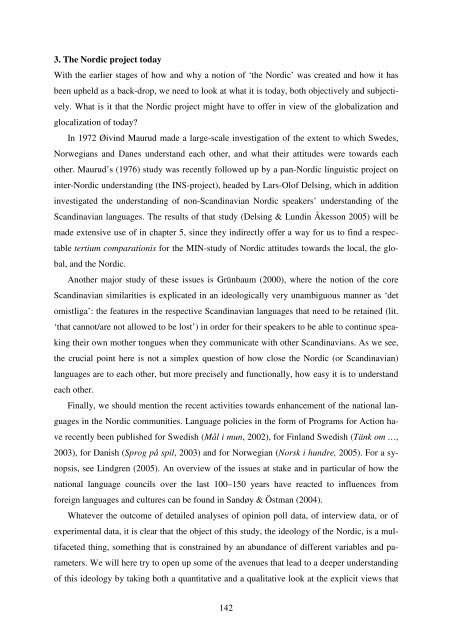Hør dog hvad de siger - Note-to-Self: Trials & Errors
Hør dog hvad de siger - Note-to-Self: Trials & Errors
Hør dog hvad de siger - Note-to-Self: Trials & Errors
Create successful ePaper yourself
Turn your PDF publications into a flip-book with our unique Google optimized e-Paper software.
3. The Nordic project <strong>to</strong>day<br />
With the earlier stages of how and why a notion of ‘the Nordic’ was created and how it has<br />
been upheld as a back-drop, we need <strong>to</strong> look at what it is <strong>to</strong>day, both objectively and subjecti-<br />
vely. What is it that the Nordic project might have <strong>to</strong> offer in view of the globalization and<br />
glocalization of <strong>to</strong>day?<br />
In 1972 Øivind Maurud ma<strong>de</strong> a large-scale investigation of the extent <strong>to</strong> which Swe<strong>de</strong>s,<br />
Norwegians and Danes un<strong>de</strong>rstand each other, and what their attitu<strong>de</strong>s were <strong>to</strong>wards each<br />
other. Maurud’s (1976) study was recently followed up by a pan-Nordic linguistic project on<br />
inter-Nordic un<strong>de</strong>rstanding (the INS-project), hea<strong>de</strong>d by Lars-Olof Delsing, which in addition<br />
investigated the un<strong>de</strong>rstanding of non-Scandinavian Nordic speakers’ un<strong>de</strong>rstanding of the<br />
Scandinavian languages. The results of that study (Delsing & Lundin Åkesson 2005) will be<br />
ma<strong>de</strong> extensive use of in chapter 5, since they indirectly offer a way for us <strong>to</strong> find a respec-<br />
table tertium comparationis for the MIN-study of Nordic attitu<strong>de</strong>s <strong>to</strong>wards the local, the glo-<br />
bal, and the Nordic.<br />
Another major study of these issues is Grünbaum (2000), where the notion of the core<br />
Scandinavian similarities is explicated in an i<strong>de</strong>ologically very unambiguous manner as ‘<strong>de</strong>t<br />
omistliga’: the features in the respective Scandinavian languages that need <strong>to</strong> be retained (lit.<br />
‘that cannot/are not allowed <strong>to</strong> be lost’) in or<strong>de</strong>r for their speakers <strong>to</strong> be able <strong>to</strong> continue spea-<br />
king their own mother <strong>to</strong>ngues when they communicate with other Scandinavians. As we see,<br />
the crucial point here is not a simplex question of how close the Nordic (or Scandinavian)<br />
languages are <strong>to</strong> each other, but more precisely and functionally, how easy it is <strong>to</strong> un<strong>de</strong>rstand<br />
each other.<br />
Finally, we should mention the recent activities <strong>to</strong>wards enhancement of the national lan-<br />
guages in the Nordic communities. Language policies in the form of Programs for Action ha-<br />
ve recently been published for Swedish (Mål i mun, 2002), for Finland Swedish (Tänk om …,<br />
2003), for Danish (Sprog på spil, 2003) and for Norwegian (Norsk i hundre, 2005). For a sy-<br />
nopsis, see Lindgren (2005). An overview of the issues at stake and in particular of how the<br />
national language councils over the last 100–150 years have reacted <strong>to</strong> influences from<br />
foreign languages and cultures can be found in Sandøy & Östman (2004).<br />
Whatever the outcome of <strong>de</strong>tailed analyses of opinion poll data, of interview data, or of<br />
experimental data, it is clear that the object of this study, the i<strong>de</strong>ology of the Nordic, is a mul-<br />
tifaceted thing, something that is constrained by an abundance of different variables and pa-<br />
rameters. We will here try <strong>to</strong> open up some of the avenues that lead <strong>to</strong> a <strong>de</strong>eper un<strong>de</strong>rstanding<br />
of this i<strong>de</strong>ology by taking both a quantitative and a qualitative look at the explicit views that<br />
142



